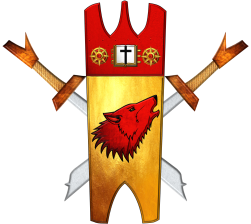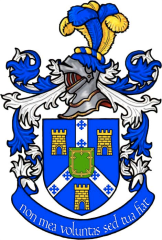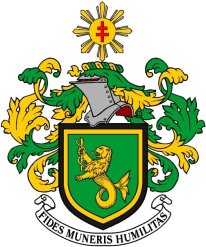
You can use the parts of a coat of arms to make a design that is your very own, and that carries meaning that you can pass on to future generations.
Download this blank kalasag template and create your own coat of arms! This template is free to use under a Creative Commons licence (CC BY-NC-SA 4.0): you may copy and adapt for non-commercial use, with credit to the Philippine Armorial.

Native pride and colonial heritage – Philippine heraldry is a unique combination of local and Western traditions. Image from Rendell Tamaca Salgado.
Heraldry started on battlefields in medieval Europe: painted shields and cloaks (“coats of arms”) were the only way that knights could identify their allies and enemies. Of course this was never necessary in the Philippines, but heraldry today still serves the same purpose: identification. Simple designs with symbols that refer to personal or family history are best, because they will hold meaning and importance as they are passed from generation to generation.
Personal heraldry in the Philippines is unregulated. Anyone can design and use (“assume”) their own coat of arms. There are no official rules and no government agencies that control how a Filipino can adopt a coat of arms, but our history as both a Spanish and then an American colony has established a few practices that help define Philippine personal heraldry:
Spanish:
- Coats of arms follow a basic structure of charges (symbols), displayed on a shield, underneath a crest (usually a helmet or other headdress along with other symbols above the shield)
- Only the essential colors of blue, red, purple, black and green, and the “metals” silver (white) and gold (yellow) can be used
- Every coat of arms traces back to a single person, and the right to use it can only be inherited by relatives of that person. Simply having the same family name is not enough: although there are many names of Spanish origin in the Philippines, it is usually impossible to confirm any actual blood or adoptive relationships with the original Spanish conquerors and colonists who had coats of arms. In fact, most Filipinos have absolutely no blood or adoptive relationship to any Spanish family of the same name: Spanish names were simply assigned during colonization. It is better to design a new coat of arms – one that reflects your real family – than take one that just happens to be associated with the same family name, if a blood or adoptive relationship cannot be proven.
- Coats of arms can be inherited from both the mother’s and father’s side of the family, not just the father’s, as some other European countries traditionally do.
- Some types of designs are reserved for particular uses. For example, in personal heraldry, a quartered design – a shield divided into four parts, with different items and colors in the upper left, upper right, lower left and lower right – implies the combination of four different shields joined by inheritance or marriage. Quartering should not be used in new, modern designs for an individual, outside of inheritance or marriage.
American:
- Everyone is free to adopt their own new coat of arms, regardless of family history, social class or wealth
- A coat of arms celebrates personal or family identity, but does not indicate nobility, superiority or other special privilege
- As a republic where all people are equal, elements that are associated with royalty or nobility should not be used, like supporters (people, animals or other creatures) beside the shield. Above the shield, barred or open helmets, coronets or crowns should not be used. While some families sometimes retain such elements if previously granted or attributed to ancestors, they have no modern significance and are not used in new designs
- (Learn more about American heraldry traditions at the American Heraldry Society.)
It has never been legitimate anywhere for a person to take someone else’s arms for his own. Since arms are hereditary emblems of identity, the proven descendants of a person who bore arms have a right to those arms in accordance with the rules of heraldic succession applicable to the place and time. However, the mere coincidence of bearing the same family name as another person is not proof of descent from that person. Commercial enterprises that claim to sell the arms of a name do so under false pretences, and anyone who pays them for such arms has been duped. (American Heraldry Society)
Philippine symbols in a coat of arms
Coats of arms usually focus on symbols that refer to personal or family history: service, work, education, faith, values, home town, and so on. Most Filipinos have designed their own coats of arms to also include elements that indicate Philippine heritage. Some possible symbols are:
- shield in the shape of a kalasag (rectangle with oval cutouts) or taming (round), historic forms associated with native warriors

The kalasag shield and kampilan swords are unmistakeable symbols of the Philippine warrior spirit. Image from Rendell Tamaca Salgado.
- instead of a medieval knight helmet on top of the shield as commonly seen in European heraldry, a traditional Filipino hat like a salokot or a Spanish Castilian morion

The round-bottom shield and morion helmet reflect our Spanish heritage. Image from Rendell Tamaca Salgado.
- characters in Baybayin

A script in baybayin on the Escriva arms celebrates our pre-colonial heritage. Image from Jet Tevar.
- the colors blue, red, yellow and white, reflecting our national flag and coat of arms

The Benemerito coat of arms features Philippine national colors. Image from American College of Heraldry.
- suns or stars, reflecting our national flag and coat of arms

The Mangahis coat of arms features a Philippine sun. Image from American College of Heraldry.
- weapons, like the kampilan sword or balisong knife
The inverted Y-shape on the Pinpin coat of arms refers to a balisong knife. Image from the International Association of Amateur Heralds.
- flowers or trees, like the sampaguita or anahaw
The Macalisang coat of arms features an anahaw leaf above the helmet. Image from the Chinese Armorial.
- animals, like the carabao or tarsier
The Payumo coat of arms features a sealion. Image from the American College of Heraldry.
- shapes or colors that represent your home town
The green band surrounded by blue bands on the Suarez coat of arms represent the Philippines (land surrounded by ocean) and Manila (land surrounded by the bay and the ocean). Image from the US Heraldic Registry.
- animals in Philippine mythology and legend, like the bakunawa dragon or sarimanok bird
Local government heraldry can sometimes be useful to find ideas to represent your home town or province. Existing designs should not be copied or modified, but can give inspiration for potential symbols. (Learn more about government heraldry on the Interactive Registry of Government Seals and Symbols of the State.)
Unfortunately, most seals and flags are based on existing national symbols and aren’t unique, or use complicated scenes or landscapes that can’t be used directly in a personal coat of arms. However, some artists have been able to create meaningful and simple unofficial symbols based on the official designs, that show how you can develop elements for a coat of arms:
The official seal for Muntinlupa does not have any unique symbols that are specific to the area: stars, an eagle and the national colors could represent any Philippine city. However, Timow Paragas was able to adapt the meaning of the official seal into a unique design: an octagon to symbolize the Emerald City, and 3 3-pointed stars for the 9 barangays and the 3-word motto. Images from the Interactive Registry of Government Seals and Timow Paragas.
The official seal for Negros Occidental uses a complicated landscape of a farm and a seascape of a ship to symbolize the province’s sugar farming and exporting industry. Landscapes are not appropriate for a coat of arms. Instead, Timow Paragas designed a simple and memorable emblem: a hexagon that reflects the chemical shape of glucose. It also incorporates a historic symbol associated with the Province. Images from the Interactive Registry of Government Seals and Timow Paragas.
The Roman Catholic church is also a potential source of ideas for symbolism. Coats of arms of the Philippines’ ecclesiastical jurisdictions often draw from local geography or history.






Regional coats of arms of the Roman Catholic church reflect the geography and history of where its parishes are found. Images by Gonzalo Sy-Quia Jr and Roberto Rodriguez, from “The Coats of Arms of the Ecclesiastical Jurisdictions of the Philippines”, by Mariano Mariaga, in Philippine Studies, June 1957.
Registering a coat of arms
Because personal heraldry is not regulated in the Philippines, there is no need to register a coat of arms in order to use one. However, registration can be helpful to establish ownership of a particular design for you and your family, and prevent usurping (the “stealing” of a coat of arms) or copying, whether intentional or not. More importantly, registration will record your coat of arms for your family and future historical research. You should explain what your design means so that they will understand what you are commemorating.

The Brillantes coat of arms was registered with the the Cronista de Armas for Castille and Leon, in Spain. The text indicates it is associated with an officer of the Philippine military. Image by Sulbud from Wikipedia.
Although the National Historical Commission has a Heraldry Division, it is not involved with personal heraldry. The Philippine Armorial therefore acts as a public register and reference for personal and family coats of arms. Because of our colonial history, many Filipinos have submitted their coats of arms for registration by a Cronista de Armas in Spain, or US registers of coats of arms, such as the options listed by the American Heraldic Society.
Non-noble (“burgher”) arms may be registered by a Cronista to place them under the protections of Spanish law. There is no specific procedure to obtain a certification of arms in Castilla y León, as stated in the Organic Law 30/1992 of the Legal Regime of the Public Administrative of Common Administrative Procedure.
There are however certain factors the Cronistas look in deciding if a burgher petitioner is worthy of bearing arms. Although there are no set criteria for a successful petition, awards, honors, civil or military commissions, university degrees, professional achievements, and recognition either national or local are considered, requiring submission of a Curriculum Vitae.
The issuance and registration of Arms in Castilla y León is gratuitous, as is the charge of the office of Cronista de Armas de Castilla y León. However, there are administrative fees for document production, processing, including legal and mailing fees to be paid by the petitioner. (Procedure for obtaining a certification of arms in Castilla y León)
Filipinos in countries where heraldry is regulated (like the UK) should check their local authorities for guidance about adopting and using a coat of arms. The American Heraldry Society has a good reference on heraldic authorities around the world.

The coat of arms of Ricardo Gonzales Suarez are registered with the US Heraldic Registry. Online registers like these help ensure that the design is recorded publicly, and that the image and symbolism can be found by future researchers as well as family. Image from the US Heraldic Registry.
Register your coat of arms on the Philippine Armorial
Philippine citizens and residents, as well as everyone of Philippine heritage regardless of citizenship or residency, are welcome to register their arms with the Philippine Armorial. We record personal and family arms, badges and other heraldic devices, blazon, biographical and background information for permanent public reference. Please use the Registration request form, or contact us at philippinearmorial@gmail.com or on our Contact page. There is no fee for registration.
Filipino Catholics are also welcome to register at the Escudos Ecclesiasticos PH Registry, by the Ecclesiastical Section of the Filipino Heraldry Society.









Thanks for following and the attribution.
Unfortunately, the designs that I made in 2015 was intended for flags and not for escutcheons. Although, both can fit into the shield.
LikeLike
Thank you Sir Timow for your comment and for your wonderful design work. Our intent was to use your art as examples of how scenes or generic items like stars can be reimagined as more meaningful and memorable symbols. The best designs are those that are versatile enough to work in any shape, whether shields or flags, and we believe yours are exactly that. Incidentally if you have a coat of arms we would be honored to showcase it here. Thank you again Sir Timow.
LikeLiked by 1 person
Would it be feasible to establish in this website a de facto listing of coats of arms? Or is it the intent of this page to be the register of sorts for Philippine coat of arms (privately owned and maintained, though)?
I am very much interested in making my own and promoting its use with others.
LikeLike
Thank you Sir Guilar for your question. The Philippine Armorial functions as essentially both – to preserve and promote personal and family heraldry in the Philippines, we list coats of arms found through our research and recommended sources, as well as offer a place for Philippine armigers to publicly record the design and meaning of their arms. We would be happy to consider your arms for inclusion and add them to our roll.
LikeLike
Thanks for the reply! I’m currently designing my arms and once finished, I hope to submit it to be enrolled here.
LikeLike
I am currently designing my coat of arms, upon reading the above article I am now somewhat confused. These days can I freely use supporters beside the shield in my COA design???
LikeLike
Hi Jherwin, there is no legal regulation of personal coats of arms in the Philippines so you would not be breaking any laws if you used supporters with your arms. However, the Philippines is a Republic that has rejected royalty and nobility (s. 31 of the Constitution), so it is inappropriate in Philippine practice to publicly use supporters in personal arms, because they traditionally imply the individual is asserting to be “royalty” or “nobility”. Hope this helps, Vincent for the Philippine Armorial.
LikeLike
Thank you
LikeLike
Is it ok to use a mask figure instead of a helmet above the shield?
LikeLike
What do you mean by “mask figure”? It is reasonable to use another type of headgear instead of a helmet, like a salokot.
Sometimes coats of arms are depicted without a helmet and mantling, and the crest (the part that is usually on top of the helmet) is placed directly on top of the shield. This is often called “middle arms”, as compared to the “full arms” that includes the helmet and mantling. So if the “mask figure” is the crest, it is possible to put it directly on top of the shield as a “middle arms” version of the emblazonment.
It would be helpful to see a picture of what you mean – please feel free to send an email to philippinearmorial@gmail.com. Hope this helps!
LikeLike
A literal mask. For example like rhe vendetta mask
LikeLike
Sure, that could be done. For example, if the arms at https://reg.gg.ca/heraldry/pub-reg/project-pic.asp?lang=e&ProjectID=1057&ProjectElementID=3685 were drawn in the “middle arms” format, then it would be the shield, with theatrical mask immediately on top of the shield. As long as it is understood that the mask is not taking the place of the traditional helmet.
LikeLike
I have sent an email at philippinearmorial@gmail.com for the sample reference of the mask. Please check if that kind of design is allowed.
LikeLike
Good afternoon, can I make my own family coat of arms and register it?
LikeLike
Hi Ram, yes you can: everyone in the Philippines is free to design their own coat of arms. Once designed and drawn, you are welcome to submit it for registration as described above.
LikeLike
Just requested for registration I hope its approved!
LikeLike
how to register? a family crest?
LikeLike
Hi William, thanks for the enquiry. To register, simply complete the form at https://forms.gle/njgbPqsfmCycsup26. If you have trouble with the form, please send us a note on philippinearmorial@gmail.com. Thank you.
LikeLike